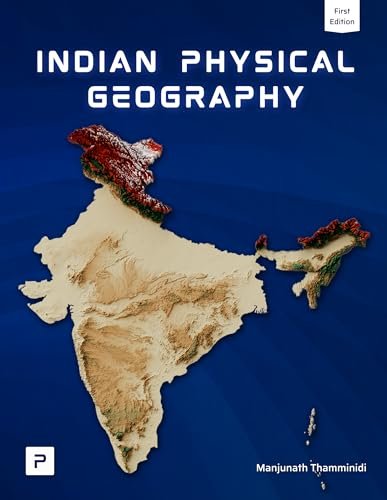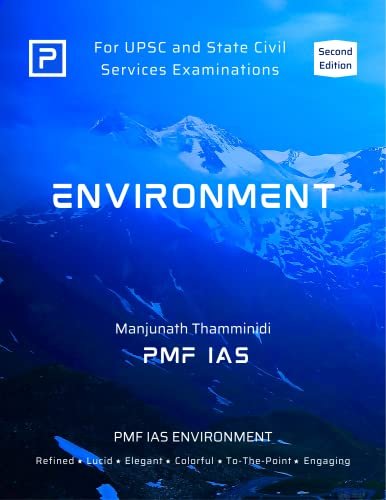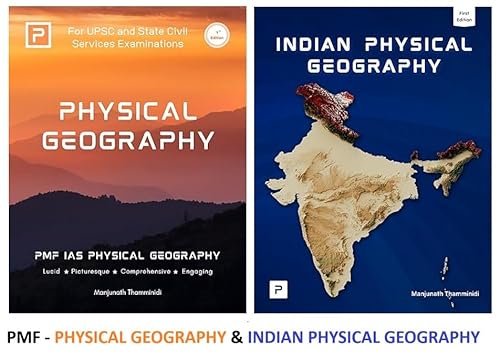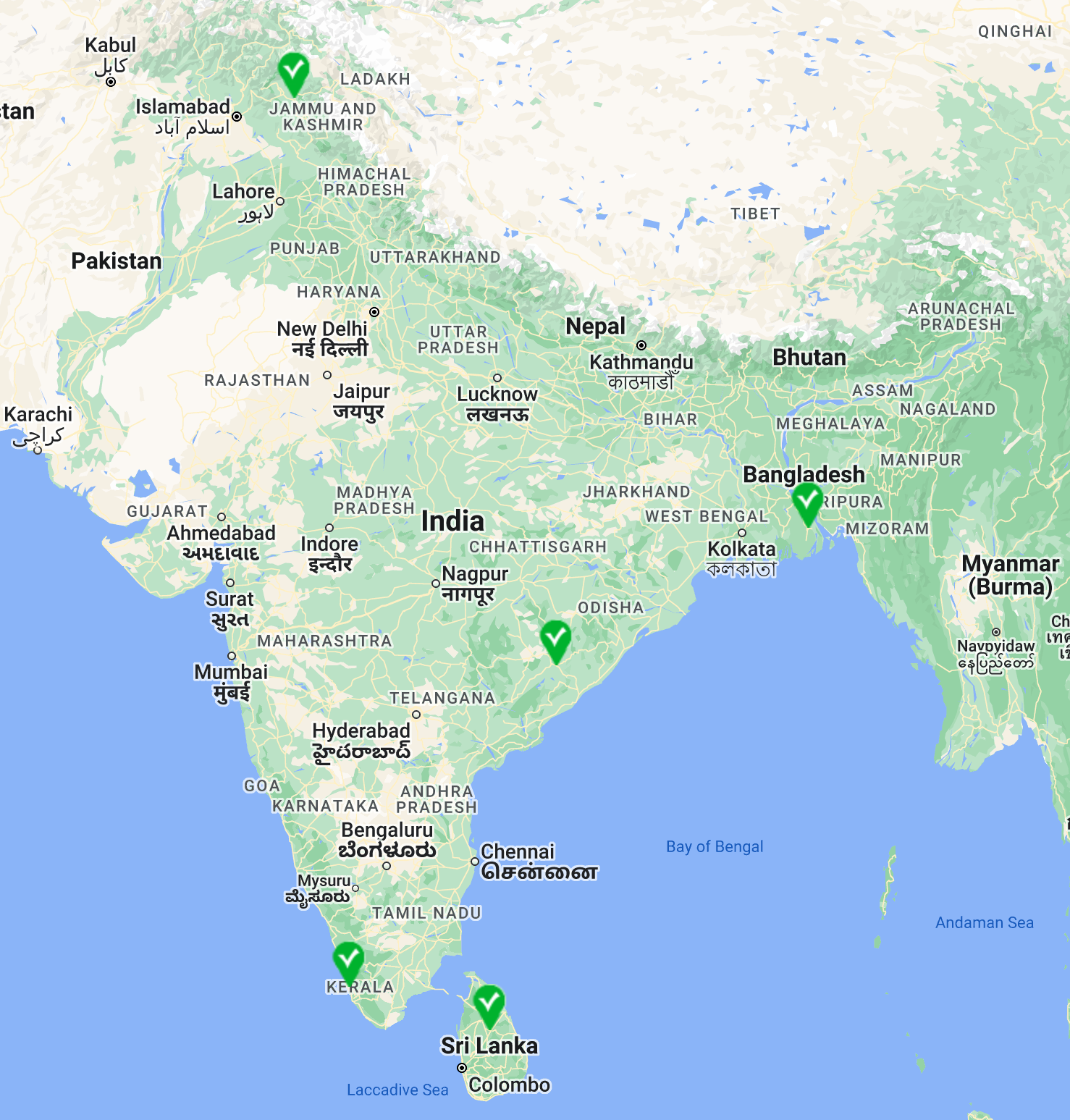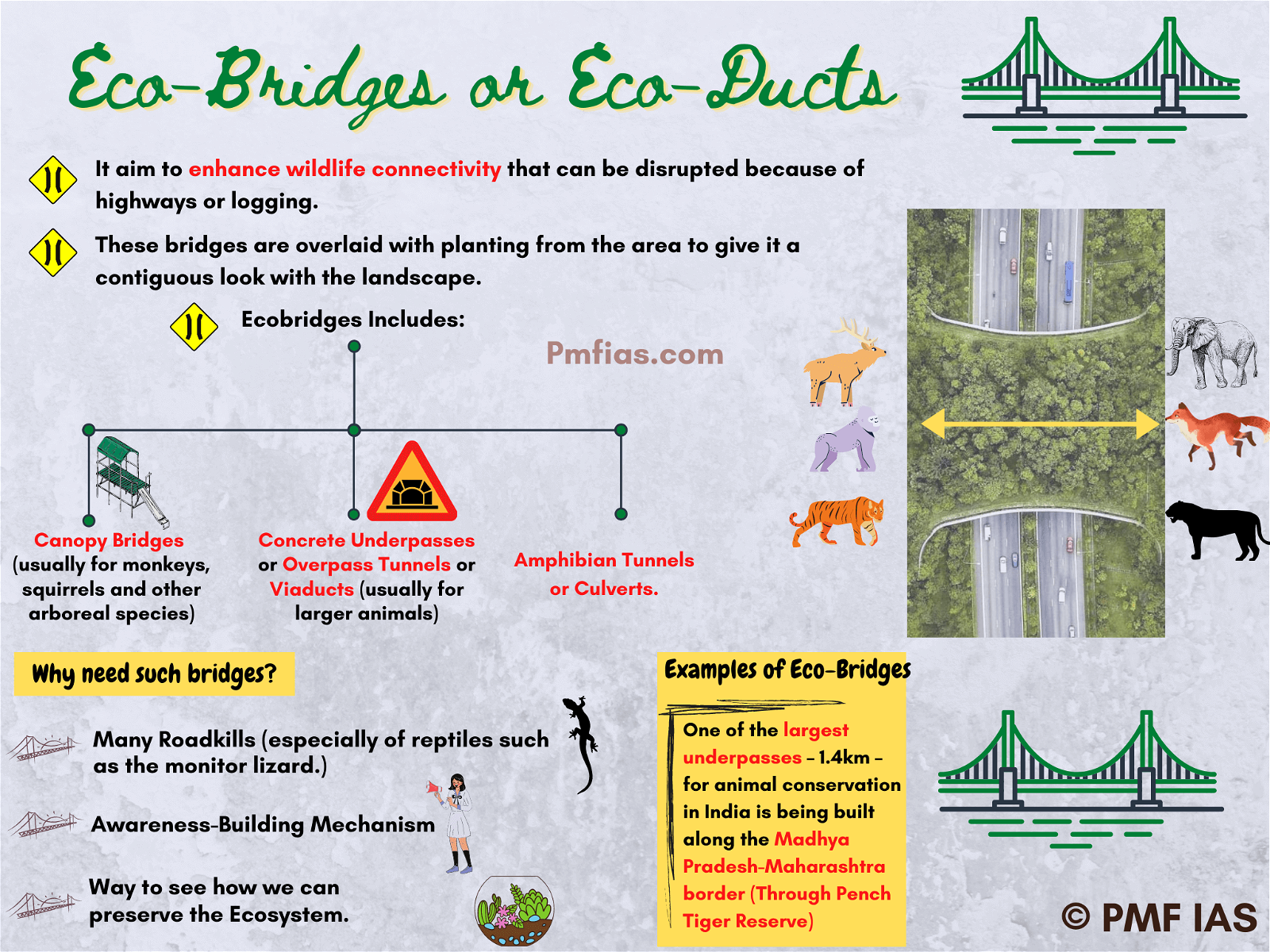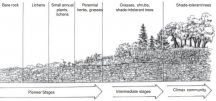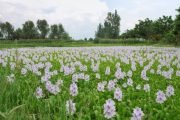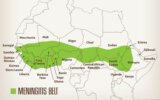
Land Degradation, Soil Erosion and Soil Conservation
Subscribe to Never Miss an Important Update! Assured Discounts on New Products!
Must Join PMF IAS Telegram Channel & PMF IAS History Telegram Channel
Last updated on April 19, 2024 9:30 PM
Land Degradation
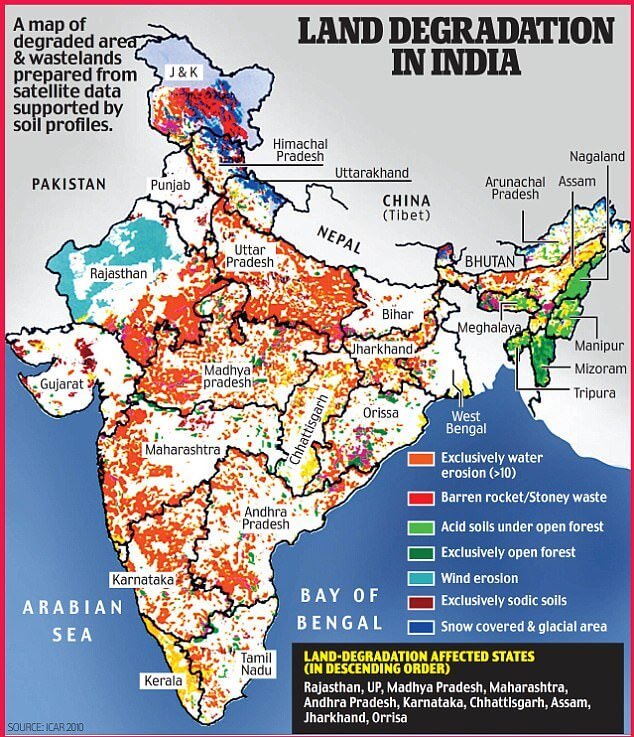
- Soil degradation is the decline in soil quality caused by its improper use, usually for agricultural, pastoral, industrial or urban purposes.
- Soil degradation is a serious global environmental problem and may be exacerbated by climate change.
- It encompasses physical (soil erosion), chemical (salinity and alkalinity, pollution) and biological deterioration (pollution and deterioration of vegetal cover).
Deforestation
- The population explosion has created pressure on forest land and resources, and this causes deforestation.
- Deforestation accentuates soil erosion (soil degradation).
- Roots of trees and plants bind the soil particles and regulate the flow of water, thus saving soil from erosion. Deforestation makes soil vulnerable to wind and water erosion.
- The large scale damage to the soil in Shiwalik range, the Chos of Punjab, the ravines of Chambal valley are due to deforestation.
Major Causes of Deforestation
Shifting cultivation
- In this practice a patch of land is cleared, vegetation is burned, and the ash is mixed with the soil thus adding nutrients to the soil.
- This patch of land is used for raising crops for two to three years, and the yield is modest.
- Then this area is abandoned and is left to recover its fertility, and the same practice is repeated elsewhere on a fresh piece of land.
- This agricultural practice has become unsustainable due to rapid increase in population pressure in the forested areas.
Development project and Mining
- Opencast mining has resulted in deforestation all over the world.
Plantation Boom
- Increase in demand for cocoa, coffee, tea, sugar, palm oil, rubber etc. have resulted in deforestation in the tropical rainforests.
Raw Materials
- Wood is used as a raw material by various industries for making paper, plywood, furniture, match sticks, boxes, crates, packing cases, etc.
- Industries also obtain their raw materials from plants such as drugs, scents and perfumes, resin, gums, waxes, turpentine, latex and rubber, tannis, alkaloids, bees wax.
Other Causes
- Deforestation also results from overgrazing, agriculture, mining, urbanisation, flood, fire, pest, diseases, defence and communication activities.
Effects of Deforestation
- Closed forests (based on canopy level) have diminished due to deforestation leading to an increase in degraded forests.
- Forests recycle moisture (natural motors) from soil into their immediate atmosphere by transpiration where it again precipitates as rain.
- Deforestation results in an immediate lowering of groundwater level (low percolation due to the quick surface runoff on barren lands) and in long-term reduction of precipitation.
- Due to deforestation, this natural reuse cycle is broken, and water is lost through rapid runoff.
- Deforestation affects the biota and neighbouring ecosystems, soil erosion, land degradation, alteration of groundwater channels, pollution and scarce.
Overgrazing
- During the rainy season, there is plenty of vegetation and animals get enough fodder.
- But during the dry period, there is a shortage of fodder, and the grass is grazed to the ground and torn out by the roots by animals.
- This leads to lose structure of the soil and the soil is easily washed away by rains.
- Moreover, the soil is pulverised (reduce to fine particles) by the hoofs of animals and thus proves detrimental to topsoil when heavy showers fall on it.
- Soil erosion due to overgrazing is a common site in the hilly areas.
Faulty Methods of Agriculture
- Much of the soil erosion in India is caused by faulty methods of agriculture.
- Wrong ploughing, lack of crop rotation and practice of shifting cultivation are the most adversely affecting methods of agriculture.
- If the fields are ploughed along the slope, there is no obstruction to the flow of water and the water washes away the topsoil easily.
- In some parts of the country, the same crop is grown year after year which spoils the chemical balance of the soil. This soil is exhausted and is easily eroded by wind or water.
- The removal of the forest cover shifting cultivation leads to the exposure of the soil to rains and sun which results in heavy loss of topsoil, especially on the hill slopes.
Soil Salinity and Soil Alkalinity
- In Saline and Alkaline Soils, the topsoil is impregnated (soak or saturate with a substance) with saline and alkaline efflorescences (become covered with salt particles).
- Undecomposed rock fragments, on weathering, give rise to sodium, magnesium and calcium salts and sulphurous acid.
- Some of the salts are transported in solution by the rivers.
- In regions with low water table (due to over irrigation in canal irrigated areas), the salts percolate into the subsoil, and in regions with good drainage, the salts are wasted away by flowing water.
- But in places where the drainage system is poor, the water with high salt concentration becomes stagnant and deposits all the salts in the topsoil once the water evaporates.
- In regions with the high sub-soil water table, injurious salts are transferred from below by the capillary action as a result of evaporation in the dry season.
- In canal irrigated areas plenty of the water is available, and the farmers indulge in over irrigation of their fields.
- Under such conditions, the groundwater level rises and saline and alkaline efflorescences consisting of salts of sodium, calcium and magnesium appear on the surface as a layer of white salt through capillary action.
- Vast tracts of canal irrigated areas in Uttar Pradesh. Punjab and Haryana; arid regions of Rajasthan, semi-arid areas of Maharashtra, Gujarat, Andhra Pradesh, Telangana and Karnataka etc. are facing this problem.
- Although Indira Gandhi canal in Rajasthan has turned the sandy desert into a granary, it has given birth to serious problems of salinity and alkalinity.
Q. Which of the following is/are the possible consequence/s of heavy sand mining in riverbeds? (2018)
- Decreased salinity in the river
- Pollution of groundwater
- Lowering of the water-table
Select the correct answer using the code given below:
- 1 only
- 2 and 3 only
- 1 and 3 only
- 1 ,2 and 3
- Water accumulates in the (pores) space between soil particles and can stay in these spaces’ dues to capillary action (capillary action explained in Indian Geography > Soils > Saline – Alkaline Soils).
- Capillary action occurs because water is sticky and helps the water in pores overcome gravity.
- It is because of the capillary action that water (water table) is available just a few feet below the top soil.
- When the soil is removed the capillary action is lost and the water table falls.
- In places of high water table (near marshlands, wetlands, river beds) when the top soil is removed the water table is exposed to sunlight and evaporation increases salinity.
- Also, soil acts as a filter and when it is removed the pollutants manage to reach the ground water more easily.
Answer: b) 2 and 3 only
Effects of salinity and alkalinity
- Salinity and alkalinity have an adverse effect on soil and reduce soil fertility.
- Cultivation is not possible on saline soils unless they are flushed out with large quantities of irrigation water to leach out the salts.
- Choice of crops is limited to salinity-tolerant crops like cotton, barley etc.
- Quality of fodder and food produced is of poor quality.
- Salinity and alkalinity create difficulties in building and road construction.
- These cause floods due to reduced percolation of water.
Steps to treat salinity and alkalinity
- Providing outlets for lands to drain out excess water and lower water table.
- Seal leakages from canals, tanks and other water bodies by lining them.
- Making judicious use of irrigation facilities.
- Improve vegetal cover to avoid further degradation by planting salt-tolerant vegetation.
- Crop rotation.
- Liberal application of gypsum to convert the alkalis into soluble compounds.
- Alkali can be removed by adding sulphuric acid or acid forming substances like sulphur and pyrite.
- Organic residues such as rice husks and rice straw can be added to promote the formation of mild acid as a result of their decomposition.
Desertification
- Desertification is the spread of desert-like conditions in arid or semi-arid areas due to man’s influence or climatic change.
- A large part of the arid and semi-arid region lying between the Indus and the Aravalli range is affected by spreading desert conditions.
- Desert soils suffer maximum erosion by wind. The sand carried by wind is deposited on the adjoining fertile lands whose fertility dwindles, and slowly the fertile land starts merging with the advancing desert.
- It has been estimated that the Thar Desert is advancing at an alarming rate of about 0.5 km per year.
- The process of desertification is attributed to uncontrolled grazing, reckless felling of trees and growing population. Climate change has also contributed to the spread of deserts.
Ecological implications of desertification
- Drifting of sand and its accumulation on fertile agricultural land.
- Excessive soil erosion by wind and to some extent by water.
- Deposition of sand in rivers, lakes decrease their water containing capacity.
- Lowering of water table leading to acute water shortage.
- Increase in area under wastelands.
- Decrease in agricultural production.
- Increase in frequency and intensity of droughts.
Measures of Controlling Desertification
- Intensive tree plantation in the transition zones.
- Mulching shifting sand dunes in deserts with different plant species. Mulches serve as an effective physical barrier to the moving sand.
- Grazing should be controlled, and new pastures should be developed.
- Indiscriminate felling of trees should be banned.
- Alternative sources of fuel can reduce the demand for fuelwood.
- Sandy and wastelands should be put to proper use by judicious planning.
Waterlogging
- The flat surfaces and depressions result in waterlogging.
- Waterlogged soils are soaked with water accumulated during the rainy season or due to leakage from various water sources.
- The extent of waterlogged soils is about 12 million hectares in India – half of which lies along the coast and the other half in the inland area.
- Waterlogging is believed to be one of the chief causes of salinity.
- Proper layout of drainage schemes is the only way to overcome the menace of waterlogging.
- The basic methods of removing excess water from waterlogged soils are (a) surface drainage and (b) vertical drainage.
- Surface Drainage. Surface drainage involves the disposal of excess water over ground surface through an open drainage system with an adequate outlet.
- Vertical Drainage. Any bore or well from which the underlying water is extracted is defined as vertical drainage. It works well in Indo-Gangetic plain where the pumped water is used for irrigating the neighbouring regions.
Characteristics of Indian Soils
- Most soils are old and mature.
- Soils of the peninsular plateau are much older than the soils of the great northern plain.
- Indian soils are largely deficient in nitrogen, mineral salts, humus and other organic materials.
- Plains and valleys have thick layers of soils while hilly and plateau areas depict thin soil cover.
- Some soils like alluvial and black soils are fertile while some other soils such as laterite, desert and alkaline soils lack infertility and do not yield a good harvest.
- Indian soils have been used for cultivation for hundreds of years and have lost much of their fertility.
Soil Erosion
- Soil erosion is the loosening and displacement of topsoil particles from the land.
- Soil erosion in nature may be
- a slow process (or geological erosion) or
- a fast process promoted by deforestation, floods, tornadoes or other human activities.
- These two processes are explained below:
Water Erosion
- Running water is one of the main agents, which carries away soil particles.
- Soil erosion by water occurs by means of raindrops, waves or ice.
- Soil erosion by water is termed differently according to the intensity and nature of erosion.
- Raindrop erosion (ii) Sheet erosion (iii) Rill erosion (iv) Steam banks erosion (v) Erosion due to landslides (vi) Coastal erosion.
Raindrop erosion
- Raindrops behave like tiny bombs when falling on exposed soil, displace soil particles and destroy soil structure.
- Average size of a raindrop is approximately 5 mm in diameter falling through the air hits the soil at a velocity of 32 km/hr.
- Presence of vegetation on land prevents raindrops from falling directly on the soil thus erosion of soil in areas covered by vegetation is prevented.
Sheet erosion
- The detachment and transportation of soil particles by flowing rainwater is called sheet or wash off erosion.
- This is a very slow process and often remain unnoticed.
Rill erosion
- In rill erosion finger like rills appear on the cultivated land after it has undergone sheet erosion.
- These rills are usually smoothened out every year while forming.
- Each year the rills slowly increase in number become wider and deeper.
- When rills increase in size, they are called gullies. Ravines are deep gullies.

Streambank erosion
- The erosion of soil from the banks (shores) of the streams or rivers due to the flowing water is called bank erosion.
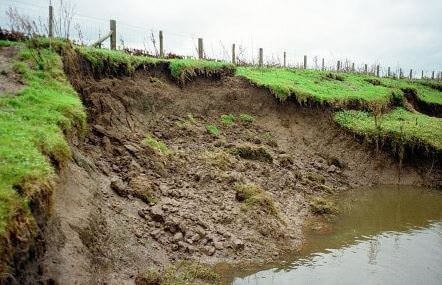
Landslide
- A sudden mass movement of soil is called a landslide. Landslides occur due to instability or loss of balance of land mass with respect to gravity.
Coastal erosion
- Coastal erosion of soil occurs along seashores. It is caused by the wave action of the sea and the inward movement of the sea into the land.
Consequences of water erosion
- Erosion removes the most fertile part of the soil. The less fertile subsoil is left.
- The fine particles of the topsoil which contain the bulk of nutrients and organic matter needed by the plants are lost from soil erosion.
- Erosion may result in removal of seeds or seedlings so that the soil becomes bare. Bare soil is more vulnerable to erosion both by wind and water.
- Removal of seeds and seedlings reduces the ability of soil to store water.
- Sheet, rill, gully and stream bank erosion also cause siltation of rivers, streams and fields.
- Deposition of silt results in damage of crops and pastures, and sedimentation of water bodies like streams, dams, reservoirs etc.
- Sedimentation of water bodies deteriorate water quality and damage aquatic habitats and organisms.
- Coastal erosion causes the adjourning land to become covered by sand.
Wind erosion
- Soil erosion by wind is more common in areas where the natural vegetation has been destroyed. Such conditions occur mainly in arid and dry areas along the sandy shores of oceans, lakes and rivers.
- The loose soil particles are blown and transported from wind by following three ways: (i) Siltation: blown by the wind in a series of short bounces. (ii) Suspension: transported over long distances in the form of suspended particles. (iii) Surface creep: transported at ground level by high-velocity winds.
Consequences of wind erosion
- Wind erosion removes the finer soil material including organic matter, clay and slit, in a suspension (colloidal) form and leaving behind coarser, less fertile material.
- The productive capacity of the soil is lost as most of the plant nutrients which remain attached smaller colloidal soil fraction are lost.
- Wind erosion also damages roads and fertile agricultural fields by depositing large quantities of air blown soil particles.
Soil Conservation
- Soil conservation is the prevention of soil from erosion or reduced fertility caused by overuse, acidification, salinisation or other chemical soil contamination.
- Soil erosion is the greatest single evil to Indian agriculture and animal husbandry.
- Notable Quotable from Khullar’s Indian Geography: “With soil conservation people rise and with its destruction, they fall. Neglect of soil is like killing the hen that lays the golden egg.”
Crop Rotation
- Adopting sustainable agricultural practices is the most important measure to conserve soil.
- In many parts of India, a particular crop is sown in the same field year after year. This practice leads to exhaustion of certain nutrients in the soil making it infertile.
- Crop rotation is a practice in which a different crop is cultivated on a piece of land each year.
- This helps to conserve soil fertility as different crops require different nutrients from the soil. Crop rotation will provide enough time to restore lost nutrients.
- For example, potatoes require much potash, but wheat requires nitrate. Thus, it is best to alternate crops in the field.
- Legumes such as peas, beans, and many other plants, add nitrates to the soil by converting free nitrogen in the air into nitrogenous nodules on their roots.
- Thus, if they are included in the crop rotation nitrogenous fertilisers can be dispensed with.
Strip Cropping
- Crops may be cultivated in alternate strips, parallel to one another. Some strips may be allowed to lie fallow while in other different crops may be sown.
- Various crops are harvested at different intervals. This ensures that at no time of the year the entire area is left bare or exposed.
- The tall growing crops act as windbreaks and the strips which are often parallel to the contours help in increasing water absorption by the soil by slowing down runoff.
Use of Early Maturing Varieties
- Early maturing varieties of crops take less time to mature and thus put lesser pressure on the soil. In this way, it can help in reducing the soil erosion.
Contour Ploughing
- If ploughing is done at right angles to the hill slope, the ridges and furrows break the flow of water down the hill.
- This prevents excessive soil loss as gullies are less likely to develop and also reduce run-off so that plants receive more water.
Checking Shifting Cultivation
- Checking and reducing shifting cultivation by persuading the tribal people to switch over to settled agriculture is a very effective method of soil conservation.
- This can be done by planning for their resettlement which involves the provision of residential accommodation, agricultural implements, seeds, manures, cattle and reclaimed land.
Ploughing the Land in Right Direction
- Ploughing the land in a direction perpendicular to wind direction also reduces wind velocity and protects the topsoil from erosion.
Mulching
- The bare ground (topsoil) between plants is covered with a protective layer of organic matter like grass clippings, straw, etc.
Benefits
- Protects the soil from erosion.
- It helps to retain soil moisture.
- Reduces compaction from the impact of heavy rains.
- Conserves moisture, reducing the need for frequent watering.
- Maintains a more even soil temperature.
- Prevents weed growth.
- Organic mulches also improve the condition of the soil. As these mulches slowly decompose, they provide organic matter which helps keep the soil loose.
Contour barriers
- Stones, grass, soil are used to build barriers along contours. Trenches are made in front of the barriers to collect water.
- They intercept downslope flowing water and soil particles. These barriers slow down the water movement and reduce its erosive force. They also filter out and trap many of the suspended soil particles, keeping them from being washed out of the field.
- A long term advantage of barriers is that soil tends to build up behind them, creating a terrace effect. Barriers can be classified as live (strips of living plants), dead (rocks, crop residues), or mixed (a combination of the previous two).
Rock Dam
- Rocks are piled up across a channel to slow down the flow of water. This prevents gullies and further soil loss.
Terrace farming
- In terracing, a number of terraces are cut along the hill slope.
- These are made on the steep slopes so that flat surfaces are available to grow crops. They can reduce surface run-off and soil erosion.
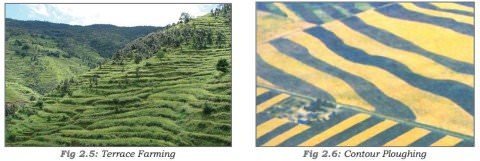
Contour Bunding
- Contour bunding involves the construction of banks along the contours.
- Terracing and contour bunding which divide the hill slope into numerous small slopes, check the flow of water, promote absorption of water by soil and save soil from erosion.
- Retaining walls of terraces control the flow of water and help in reducing soil erosion.
Intercropping
- Different crops are grown in alternate rows and are sown at different times to protect the soil from rain wash.
Contour ploughing
- Ploughing parallel to the contours of a hill slope to form a natural barrier for water to flow down the slope
Shelterbelts or Windbreaks
- In the coastal and dry regions, rows of trees are planted to check the wind movement to protect soil cover.
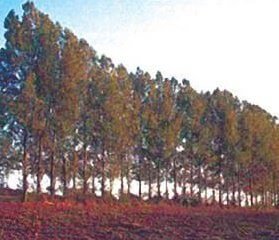
Sand fences
- Sand fences are barriers made of small, evenly spaced wooden slats or fabric. They are erected to reduce wind velocity and to trap blowing sand. Sand fences can be used as perimeter controls around open construction sites to keep sediments from being blown offsite by the wind.

Afforestation
- It includes the prevention of forest destruction along with growing new forests or increase area under forests.
- A minimum area 20 to 25 per cent of forest land was considered healthy for soil and water conservation for the whole country.
- It was raised to 33 per cent in the second five-year plan – 20 per cent for the plains and 60 per cent for hilly and mountainous regions.
Checking Overgrazing
- Overgrazing accentuates erosion. During the dry period, there is a shortage of fodder, and the grass is grazed to the ground and torn out to the roots by animals. The soil is pulverised (reduce to fine particles) by the hoofs of animals. All this leads to the weak top layer.
- So overgrazing needs to be checked to prevent soil erosion.
- This can be done by creating separate grazing grounds and producing larger quantities of fodder.
Dams
- Much of the soil erosion by river floods can be avoided by constructing dams across the rivers in proper places. This checks the speed of water and saves soil from erosion.
- But indiscriminate dam construction can worsen the condition by creating floods and landslides like it happens in the Himalayan region.
Last updated on April 19, 2024 9:30 PM

